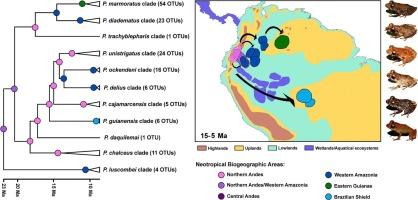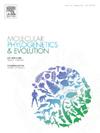The small and inconspicuous majority: Revealing the megadiversity and historical biogeography of the Pristimantis unistrigatus species group (Anura, Strabomantidae)
IF 3.6
1区 生物学
Q2 BIOCHEMISTRY & MOLECULAR BIOLOGY
引用次数: 0
Abstract
With more than 600 recognized species, the genus Pristimantis is already the most diverse among vertebrates, but described species only represent a fraction of the actual diversity in this clade. This genus is widely distributed throughout the Neotropics and represents an interesting model for biogeographic studies because Pristimantis spp. are direct developing and generally have narrow ecological niches and low dispersal abilities. The P. unistrigatus species group is one of the most important components in the genus (ca. 200 recognized species) and has been supported by morphological but not by molecular evidence. We assessed the species boundaries and distribution in the P. unistrigatus species group and infer spatiotemporal patterns of diversification related to historical landscape changes in the Neotropics. We gathered three mitochondrial, and two nuclear DNA loci from 416 specimens throughout the range of the group, and including 68 nominal species. We redefine the group based on the obtained phylogeny and found 151 candidate species that composes it, with 83 of these remaining undescribed. We recovered 11 major clades within the group that diverged before 13 Ma. The diversification of the group started during the early Miocene most likely in northwestern South America, currently corresponding to western Amazonia and northern Andes. The other neotropical areas subsequently acted as sinks, receiving lineages mostly during the last 10 Ma, after the demise of the Pebas System and the setup of the modern Amazonian hydrographic system.

小而不起眼的大多数:揭示 Pristimantis unistrigatus 物种群(无脊椎动物门,Strabomantidae)的巨型多样性和历史生物地理学。
Pristimantis 属拥有 600 多个公认的物种,已经成为脊椎动物中物种最丰富的属,但已描述的物种仅占该支系实际多样性的一小部分。该属广泛分布于整个新热带地区,是生物地理学研究的一个有趣模型,因为 Pristimantis 属是直接发育的,通常具有狭窄的生态位和较低的变异性。P. unistrigatus物种组是该属最重要的组成部分之一(约有 200 个公认的物种),已得到形态学证据的支持,但未得到分子证据的支持。我们评估了 P. unistrigatus 物种群的物种边界和分布情况,并推断了与新热带地区历史景观变化有关的物种多样化时空模式。我们从该物种群分布区的 416 个标本中收集了三个线粒体和两个核 DNA 位点,其中包括 68 个标称物种。我们根据所获得的系统发生重新定义了该类群,并发现了 151 个候选物种,其中 83 个物种仍未被描述。我们在该类群中发现了 11 个在 13 Ma 年前分化的主要支系。该类群的分化很可能始于中新世早期的南美洲西北部,目前相当于亚马孙西部和安第斯北部。其他新热带地区随后成为吸收汇,主要在最近 10 Ma 期间,即佩巴斯系统消亡和现代亚马逊水文系统建立之后接受了该类群。
本文章由计算机程序翻译,如有差异,请以英文原文为准。
求助全文
约1分钟内获得全文
求助全文
来源期刊
CiteScore
7.50
自引率
7.30%
发文量
249
审稿时长
7.5 months
期刊介绍:
Molecular Phylogenetics and Evolution is dedicated to bringing Darwin''s dream within grasp - to "have fairly true genealogical trees of each great kingdom of Nature." The journal provides a forum for molecular studies that advance our understanding of phylogeny and evolution, further the development of phylogenetically more accurate taxonomic classifications, and ultimately bring a unified classification for all the ramifying lines of life. Phylogeographic studies will be considered for publication if they offer EXCEPTIONAL theoretical or empirical advances.

 求助内容:
求助内容: 应助结果提醒方式:
应助结果提醒方式:


